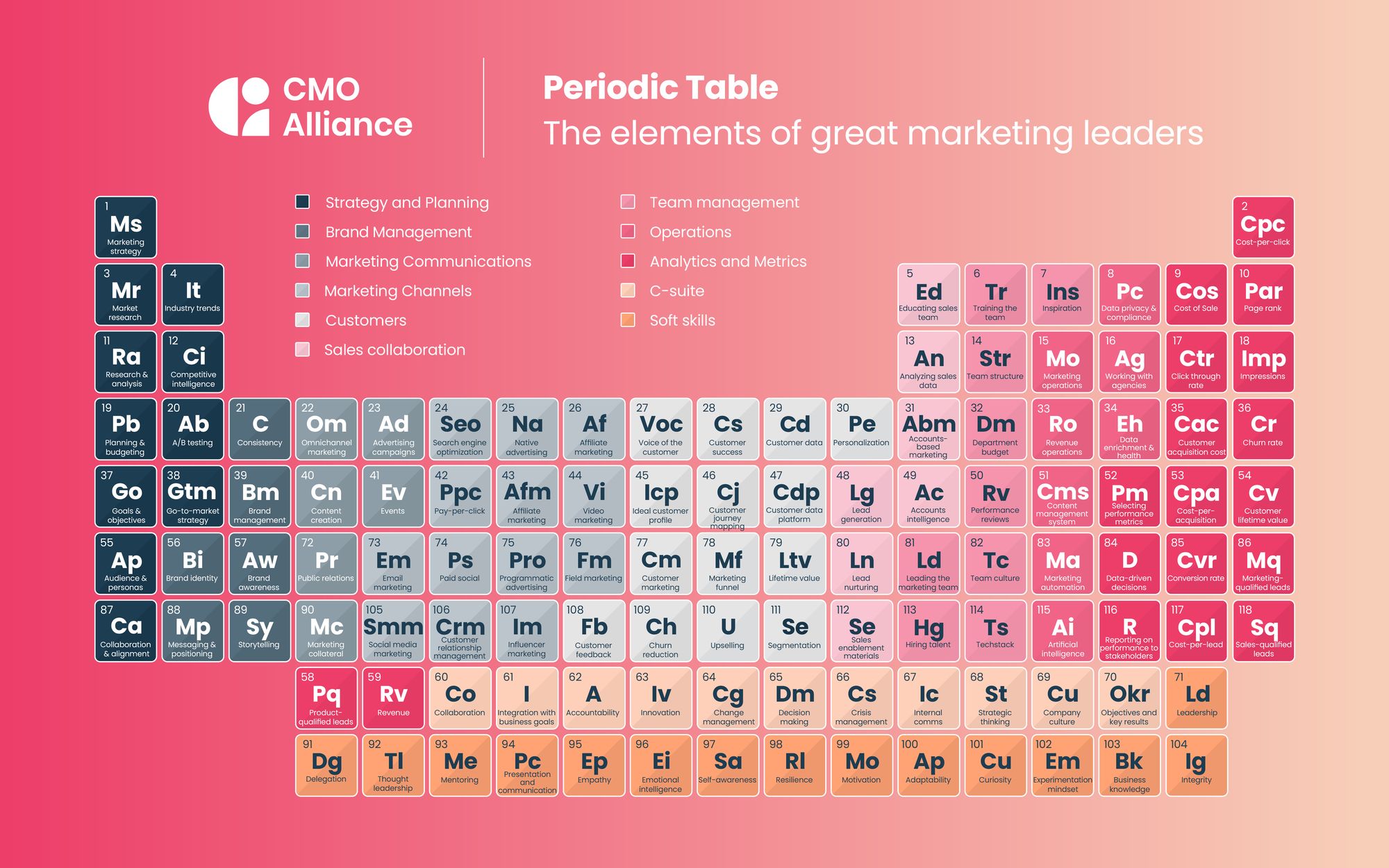Not too long ago, one of my employees asked me, “Trish, someday I want to do what you do. How do I get there?” We had a good conversation, but the question stuck with me. As I thought more about it, I realized that being a marketing leader comes with unique challenges. While there are similarities across the C-suite, heads of marketing face a distinctive landscape.

Some unicorn challenges in the midst
All organizational leaders have challenges, but marketing presents a few unique ones that we don’t necessarily share with our colleagues on the executive team.
CMOs lead teams that perform wildly different tasks
Many years ago, at an organization going through change, I was asked to stack rank my marketing team. Stack ranking is the process of grading your team members from the most to least valuable. This might be a helpful exercise if you oversee a support team, for example, with 30 people doing the same role. But in marketing? It simply doesn’t work.
Marketing leaders have teams of people who do very different tasks, from graphic design and content writing to data analysis, website development, product marketing, and event planning.
To effectively manage people as individuals and as a team, a marketing leader must have a fundamental understanding of each of the roles and personalities on their team. This eclectic team of creative and analytical types includes people with different skills, interests, and ways of thinking. I learned a long time ago that a marketing leader can’t expect to have the same conversation across each of these roles. The message that resonates with your website developer is far different from the message your marketing ops manager cares about.
CMO tenure is short, yet results take time
A recent analysis from Korn Ferry found that chief marketing officers (CMOs) have the lowest average tenure across the C-suite. Across all industries, CMOs last only 3.5 years, down from 4.1 years in 2016. In contrast, the average tenure for CEOs and CFOs is 6.9 and 4.7 years, respectively.
While a lot can be accomplished in three years—and even one year—CMOs often face unrealistic expectations around marketing results. I would bet just about every marketing leader has launched a campaign and been asked for the results the following day.
I find companies tend to lean too heavily on one marketing metric, such as quantity of leads generated, and the entire executive team may lack patience for the work required to achieve significant results. CMOs are often expected to move mountains in record time and tend to be the scapegoat when results don’t flow in quickly. The narrative around long-term goals must be stated often while also shoring up some quick wins early.
Great marketing empowers the entire business – if the org embraces it
Marketers sit in a unique seat where they can impact all areas of the business, not simply driving sales and revenue targets. Marketing also helps the company achieve its objectives by being a key influencer in customer success, product development and employee experience. A CMO can support multiple distinct areas of the business while helping other leaders understand the value of marketing goes far beyond “leads.”
To learn more about the role marketing plays in company culture, read my article, Recruitment Marketing: How Human Resources Can Lean Into Marketing.
Marketing is not the “make it pretty” team
Marketing leaders often deal with misconceptions about their team’s purpose and abilities. This idea is captured in the single phrase, “Give this to marketing to make it pretty.”
It’s true that marketing will make it pretty. Brand, after all, is important. But the message conveyed and the purpose of the piece must align.
The downside to being able to make everything pretty and plan the best parties is not being taken seriously. This is perhaps the most insidious challenge a CMO faces. While there are stereotypes about other leaders on the executive team, they generally don’t cast doubt about a leader’s seriousness.
Every marketing leader will probably get the infamous “make it pretty” request at some point. Someone will throw you something from a competitor and say, “Hey, can you just change this up and make it ours?” This is unhelpful for everyone. Copying isn’t flattery, and it isn’t great for the brand or the buyer.
Your content pieces should be part of a larger program, which includes items that are thought through and designed with cohesive objectives in mind. My team doesn’t participate in random acts of marketing. Don’t let the make it pretty requests derail the messaging and brand position.
Marketing owns the client experience—from the moment someone is introduced to the brand to when they become a full-time customer. This is a big responsibility and, to be taken seriously, we can’t let our gift for throwing amazing parties overshadow our other valuable contributions to the business.

Solutions for the unique challenges faced by chief marketing officers
While chief marketing officers face unique challenges, the response of the marketing leaders dictates success.
Prioritize mindset along with talent
Because of how many different roles marketing leaders oversee, being surrounded by talented people is essential. But talent doesn’t always equal success, especially in a team of multiple roles, responsibilities, and personalities.
While I don’t discount the importance of talent, I tend to prioritize mindset.
To survive in a marketing team, people must value curiosity and collaboration, so I look for those traits when hiring. Many skills can be learned, but if someone’s mindset isn’t aligned with the values of the team, no amount of talent will overcome that obstacle.
In a prior position, I got to know an enthusiastic receptionist who had an eye for detail and was curious about what marketing was doing. When an entry-level role came up, we took her on. She was eventually promoted to event manager, applying those skills to ensure success at events of varying sizes and scopes.
I’ve plucked people from sales ops, from development, and even from HR–and each has been extremely successful in their marketing role, making huge impacts on my current team and in other organizations where they currently work.
Mindset matters, and it’s often the difference between success and failure.
Communicate effectively with various stakeholders
Marketing leaders must be skilled communicators because we interact with multiple stakeholders, each with different needs. Our job is to align strategic and operational tactics effectively and make sure each audience knows what that means and how we’re accomplishing it.
To help my C-suite colleagues and members of my team see the whole picture, I talk about short-term and long-term efforts and results. Marketing is fast-paced, so it’s easy to forget about a campaign as soon as we start the next one. This is a mistake because so much of our work brings results over a longer outlook of 12 or more months. If we only talk about what we’re doing today, we can’t show the value of our marketing efforts, which is likely a factor in the short tenure of many CMOs.
Communicating about numbers, metrics, and results can be challenging because many “creatives” glaze over immediately when numbers come up. A marketing leader needs to understand what’s important to each employee group and tailor the messages accordingly. It takes more work, but it puts everyone on the same page and helps each team member understand the value of their contributions.
CMOs must also tailor their executive communications, especially for the chief executive officer and chief financial officer. Marketing tends to spend a lot of money, and the CFO’s perennial question is, “Why are we spending this?”
Marketing has a way of touching every facet of an organization and CMOs must demonstrate this value by communicating about more than leads. Several marketing contributions—such as transforming the customer experience and reducing turnover rates—tend to happen over a longer time horizon. Effective marketing leaders don’t let their executive teams and boards forget about these valuable contributions that can easily become invisible.
Build a team that can run itself
“Great leaders aren’t know-it-alls who continuously try to outshine everyone. Instead, they admit when they’re wrong and genuinely want to learn from others. It’s not about being the smartest person in the room. It’s about building a team with the most intelligent people you can find. When you build a team, you must see their strength as a complement to your weakness, not a threat to your position or authority. No one is an expert in everything; the most robust businesses are built on the most brilliant people–not on one person.” - Leadership First
Throughout my career, I’ve mentored many people. I look for talent and seek opportunities to help my people grow by giving them the right resources and putting them in the spotlight. Because of this approach, I’ve seen many careers soar. Helping junior and entry-level team members grow into directors and vice presidents is such a rewarding part of my work.
I believe my role as a leader is to build a team that can run without me. I do this by helping my team understand our vision, their role in that vision, and how we’ll achieve that vision together. Then we can fire on all cylinders. Once I’ve been on a marketing team for a year, I expect my team to feel comfortable having meetings or making decisions without me. To me, that means I did my job.
Real leadership is about spotting potential and helping people grow into that potential. This path isn’t unique to chief marketing officers, but it’s the foundation of my own success as a marketing leader.
Being a marketing leader means facing unique challenges, but each challenge is an opportunity to become a better leader and mentor. In my experience, these unique challenges lead to equally unique rewards, and for that, I’m grateful.
How do you feel about these myths related to marketing? Are there any others you'd like to see dispelled? Join the conversations with a global network of marketing leaders on the CMO Alliance Community Slack channel.




 Follow us on LinkedIn
Follow us on LinkedIn




